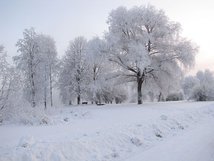Border: Finland-Russia
Date(s) of establishment: 1917; current demarcation in 1947Length of border: 1340 km
Regions concerned: Finland – Lapland, Oulu, East Finland, South Finland;
Russia – Murmansk, Karelia, Saint Petersburg
European programme(s):
- Interreg "Baltic Sea Region":
The programme on the Inforegio website - ENPI Programme "Kolarctic":
The programme on the Inforegio website - ENPI Programme "Karelia":
The programme on the Inforegio website - ENPI Programme "South East Finland–Russia":
The programme on the Inforegio website
The border begins at the tripoint between the Norwegian, Finnish and Russian borders, on the Muotkavaara hill near the lake Inari. The border, orientated north to south, does not follow any river or geographical feature, crossing very rural, sparsely populated areas, where the Taïga dominates. The terrestrial border comes to an end, on the shores of the Gulf of Finland, through which the maritime border continues, marking out the territorial waters of Finland and Estonia.
History
Finland obtained its independence from Russia in December 1917, thus creating the Russo-Finnish border. The first official demarcations date back to the Treaty of Paris (1947) which put an end to the “Continuation War” between the two parties. Following this treaty, Finland ceded Finnish Karelia and the Province of Petsamo to the Soviet Union.
The maritime border was established in 1940, but its demarcation was made more precise in 1965.
Today, the demarcation of the border causes no controversy, and is defined by law in miniscule detail.
Cross-border cooperation
With Russia being a state outside of both the European Union and the Schengen Area, whose boundaries follow the Russo-Finnish border, the pace of development of cross-border cooperation between the two countries is measured. Entry into the border area requires a special permit, and border crossings are controlled, requiring a visa. On both sides, residence in the border area also requires a special permit. The border zones can stretch to 3 km in width and their limits are indicated by painted trees, signs or plaques.
Additionally, as a state outside of the European Union, Russia is not eligible for funds from the cross-borders strand of Interreg operational programmes. However, along their shared border, Finland and Russia benefit from three ENPI programmes (European Neighbourhood and Partnership Instrument).
These programmes involve each one of the different regions of Finland, the Kolarctic, Karelia and the South-East of the country.
The “Kolartic” programme supports development in Lapland. It targets economic and social development in the border region, and tackles common challenges such as protection of the environment, management and prevention of natural hazards and other risks. More generally, this programme aims to strengthen the cross-border identity of the region and encourage meetings between the populations.
The “Karelia-Russia” programme involves the regions of Karelia lying on either side of the border. This programme focuses on improving living standards in the region, by encouraging the creation of green spaces as well as health centres. The programme also aims to boost the economic sector of cross-border cooperation, notably through the development of tourism.
The final programme encourages the development of the south of Finland and the Russian border region. The intensification of economic relations is the priority of this programme. The two additional important aspects of the programme are border security and protection of the environment.
Russia is involved in Interreg through its participation in the “Baltic Sea” operational programme (part of the transnational strand). This programme aims to increase innovation, accessibility, attractiveness and competitiveness in the region, as well as encouraging respect for the environment (particularly the marine environment).
Lastly, cooperation between Finland and Russia also resulted in the creation of the Karelia Euroregion in 1998.


